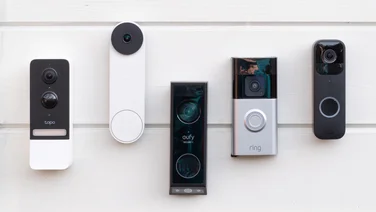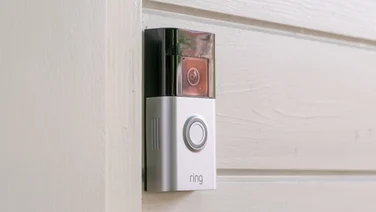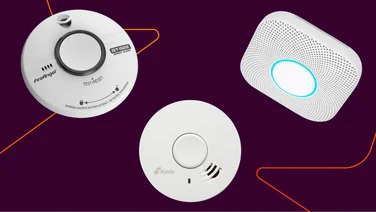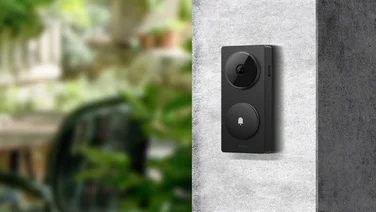To help us provide you with free impartial advice, we may earn a commission if you buy through links on our site. Learn more

The Philips In.Sight Wireless HD Monitor is pleasingly easy to set up. While other network cameras make you connect directly to the camera’s dedicated wireless network before inputting your main router’s Wi-Fi details, this information is transferred to the Philips camera through an a QR code generated in the Android or iOS app that you hold up in front of the camera’s lens. It’s an elegant arrangement that removes the need to disconnect from your main home Wi-Fi and, while a seemingly small touch, makes a big difference in terms of getting up and running quickly with the camera.

The Philips is tall and cylindrical, with a lens surrounded by a circular black bezel that makes the camera look like an Olympic mascot. There’s no external antenna, which keeps the design neat. The In.Sight’s base has an adjustable ball head for angling the camera, but there’s not a great deal of flexibility as the camera’s base is quickly obstructed by the stand when you tilt in any direction.
The In.Sight is powered by a Mini USB connection and a lengthy 3m USB cable is provided, complete with a wall adaptor. That’s it as far as connections go, as there’s no option for a wired network connection or socket to connect an external microphone.

The In.Sight has a built-in microphone to capture audio, however, and there’s even an integrated speaker. This means the camera can be used as a pseudo-intercom with the Android or iOS apps. During our tests we found that there was about a five-second delay between speaking into our smartphone and our voice being broadcast by the speaker, which made conversation tricky. However, we found the push-to-talk function didn’t always work, with the app sometimes giving out an error message. When it did work the speaker would also trigger the sound detection, so the camera would start recording. It would be better if the camera disabled sound detection momentarily when you activated the push-to-talk feature.
During the setup process you can assign each camera a different name, making it easy to manage them if you install multiple cameras throughout your home. You’ll also need to sign up to a remote monitoring account, which will then let you access the cameras over the internet when you’re outside your home network.
Like BT with its BT Home Cam 100, Philips offers optional subscription services which will let you save video footage to cloud storage. While the BT premium service saves recordings for 14 days, a Gold subscription (£27.90 per month) from Philips will save them for 30 days, while a Silver subscription (£7.99 per month) will keep your footage for just 7 days. Annual memberships work out cheaper at £279 and £79 for the two tiers.
You’re able to share access to each camera with up to four people on the Silver plan, and 16 on the Gold plan. A 14-day Silver trial is available when you first set up the In.Sight. With the Basic free package it’s possible to view the camera’s footage through the apps and your browser, as well as use the motion and sound notifications, but there are no recording capabilities.
The camera will push notifications to your device through the InSightHD app on Android and iOS whenever any activity is triggered. In the app you can refine how sensitive the camera is to movement and sound. For movement you can attempt to fine-tune the detection area by adjusting between Low and High sensitivity.
Low will only pick up big movements, while High will pick up smaller movements but may result in a lot of notifications. You can define a partial detection area, such as around a doorway, but you’re limited to just one zone. Certain other network cameras allow two or more detection zones, making it easier to cut down on false movement alerts.
Similarly, sound detection can be tailored by percentage, with 25% sensitivity only picking up loud noises. Disappointingly, both detection modes can only be turned on or off manually, with no timing or scheduling features. It would have been useful if you could schedule them to turn on when you know you will be out of the home, such as when you’re at work. As it stands you’ll need to turn detection on when you leave and off when you return, unless you want lots of notifications as you walk around the house. There’s also the risk you’ll forget to turn detection back on when you go to work or to the shops.

You also can’t save footage from the app to your device; while on the BT Home Cam 100, for example, you have the option of saving images or video locally to your smartphone or tablet, you’re limited to only capturing snapshots with the In.Sight HD, which is limiting.
Image quality in the daytime was excellent, if a little washed out. There’s still plenty of detail in the footage, and this was one of the best IP cameras we’ve seen for image quality. The In.Sight has a light sensor on top that can automatically trigger Night Vision mode when light levels drop below a certain point, and footage captured at night was also of very good quality.

Overall, the In.Sight HD is a decent IP camera with particularly good image quality, but it’s a little expensive for what it delivers. For similar money, we much prefer the versatility of the D-Link DCS-5222L, with its pan and tilt controls. Alternatively, for a little more cash, the Y-Cam HomeMonitor HD‘s free cloud storage option makes it a compelling alternative.






